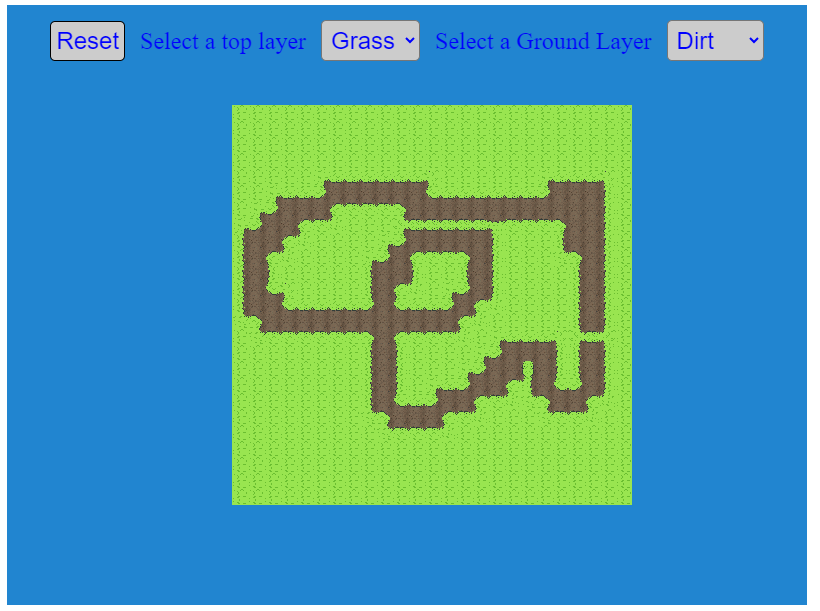
As a game developer, if the thought of hand crafting a level does not appeal to you, then you may consider looking into procedural generation for your next project. Even using procedural generation, however, you still need to be able to turn your generated map arrays into a tilemap with clean, contiguous walls, and sprites that match up cleanly, as if it was drawn by hand. This is where a technique called auto-tiling can come into play to help determine which tiles should be drawn in which locations on your tilemap.
In this article, I will explain the concept of auto-tiling, Wang Tiles, binary and bitmasks, and then walk through the process and algorithms associated with using this tool in a project.
What is auto-tiling
Auto-tiling converts a matrix or array of information about a map and assigns the corresponding tile texture to each tile in a manner that makes sense visually for the tilemap level. This uses a tile's position, relative to its neighbor tiles to determine which tile sprite should be used. Today we will focus on bitmask encoding neighbor data, although there are other techniques that can be used to accomplish this.
One can get exposed to auto-tiling in different implementations. If you're using a game engine like Unity or Godot, there are features automatically built into those packages to enabling auto-tiling as you draw and create your levels. Also, there are software tools like Tiled, LDTK, and Sprite Fusion, that are a little more tilemap specific and give you native tools for auto-tiling.
Auto-tiling has provided the most benefit when we think about how we can pivot from tilemap matrices or flat indexes representing the state of a tilemap, to a rendered map on the screen. Let us say you have a tilemap in the form of a 2d matrix with 1's and 0's in it representing the 'walkable' state of a tile. Let us assign a tile as a floor (0) piece or a wall (1) piece. Now, one can simply use two different tiles, for example:
a grass tile and a dirt path tile
We could take a tilemap matrix like this:
and use these two tiles to assign the grass to the 1's and the 0's to the path tile. It would look like this:
This is technically a tile-map which has been auto-tiled, but we can do a little better.
What are Wang tiles?
Wang tiles do not belong or associate with game development or tile-sets specifically, but come from mathematics. So, why are we talking about them? The purpose of the Wang tiles within the scope of game development is to have a series of tile edges that create matching patterns to other tiles. We control which tiles are used by assigning a unique set of bitmasks to each tile that allows us reference them later.
Wang tiles themselves are a class of system which can be modeled visually by square tiles with a color on each side. The tiles can be copied and arranged side by side with matching edges to form a pattern. Wang tile-sets or Wang 'Blob' tiles are named after Hao Wang, a mathematician in the 1960's who theorized that a finite set of tiles, whose sides matched up with other tiles, would ultimately form a repeating or periodic pattern. This was later to be proven false by one of his students. This is a massive oversimplification of Wang's work, for more information on the backstory of Wang tiles you can be read here: Wang Tiles.
This concept of matching tile edges to a pattern can be used for a game's tilemap. One way we can implement Wang tiles in game development is to create levels from the tiles. We start with a tile-set that represents all the possible edge outcomes for any tile.
These tile assets can be found here: Wang Tile Set
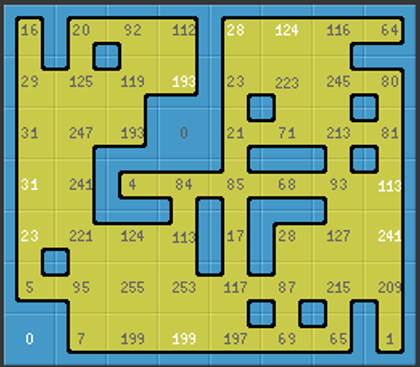
The numbers on each tile represents the bitmask value for that particular permutation of tile design. We then can see how you can swap these tiles for a separate texture below. In the image above, there are a couple duplicate tile configurations, and they are shown in white font.
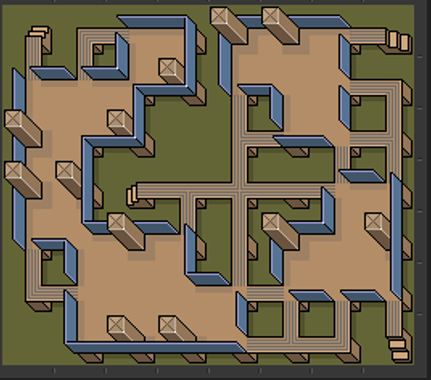
The magic of Wang tiles is that it can be extended out and create unique patterns that visually work. For example:
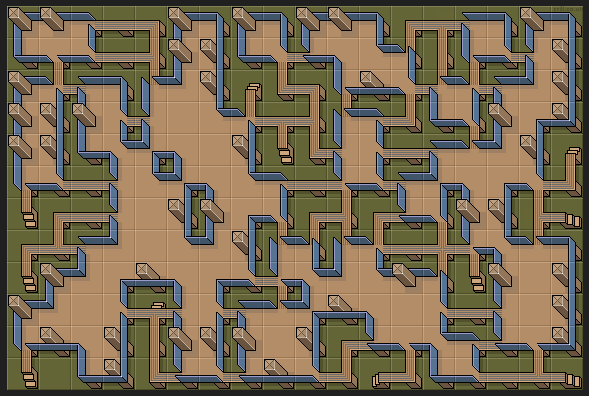
A bitmask is a binary representation of some pattern. In the scope of this conversation, we will use a bitmask to represent the 8 neighbors tiles of an given tile on a tilemap.
What is a bitmask?
A bitmask is a binary representation of some pattern. In the scope of this conversation, we will use a bitmask to represent the 8 neighbors tiles of an given tile on a tilemap.
Quick crash course on Binary
So our normal counting format is designed as base-10. This means that each digit in our number system represents digits 0-9 (10 digits), and the value of each place value increases in power of base 10.
So in the number '42', the 2 represents - (2 * 100) which is added to the 4 in the 'tens' place, which is (4 * 101), which equals 42.
T This in binary looks different, as binary is base-2, which means that each digit position has digits 0 and 1, (2 digits). This is the counting system and 'language' of computers and processors.
Quickly, let's re-assess the previous example of '42'. 42 in binary is 101010. Let's break this down in similar fashion.
Starting from the right placeholder and working our way left... The 0 in the right most digit represents 0 * 20. The next digit represents 1 * 21... and on for each digit and the exponent increases each placeholder.
Bits, Bytes, and Bitmasks
That is how information in computers is encoded. We can use this 'encoding' scheme to easily represent binary information, like 'on' or 'off', or in this discussion, walkable tile or not walkable. This is why in the tile-set matrix example above, we can flag non-walkable tiles as '1', and walkable tiles as '0'. This is now binary encoded.
A bit is one of these placeholders, or one digit. 8 of this bits together is a byte. Computers and processors, at a minimum, read at least a byte at a time.
We can use this binary encoding for the auto-tiling by representing the state of each of a tile's neighbors into 8 bits, one for each neighbor. This means that the condition and status of each neighbor for a tile can be encoded into one byte of data (8 bits) and CAN be represented with a decimal value, see my earlier explanation about how the number 42 is represented in binary.
So the whole point of this section is to get to this example: we are going to encode the neighbor's data for an example tile.
Quick Demonstration
Now the tile we are assigning the bitmask to is the green, center tile. This tile has 8 neighbors. If I start reading the 1's and 0's from the top left and reading right, then down, I can get the value: 101 (top row) - 01 (middle row) - 101 (bottom row). Remember to skip the green tile.
All together, this is 10101101, which can be stored as a binary value, which can be converted to a decimal value: 173. Remember to start at the rightmost bit when converting.
Now we can use that decimal value of 173 to represent the neighbor pattern for that tile. Every tile in a tilemap, can be encoded with their 'neighbors' bitmasks.
As you saw earlier, the wang tiles had bitmask values assigned to them. This is how we know which tile to substitute for each bitmask.
The Process
We have already covered the hard part. In this section we are pulling it all together in a walkthrough of the overall high level process.
Here are the steps we are covering:
Find or create a tile-set spritesheet that you would like to use Create your tilemap data, however you like. Loop through each index of tile, and evaluate the neighbor tiles, and assign bitmask Map the bitmap values to the 'appropriate' tile in your tile-set (this is the long/boring part IMO) Iterate over each tile and assign the correct image that matches the bitmask value Draw your tilemap in your game Creating a tile-set Here is an example of a tile-set that I drew for the demo project.
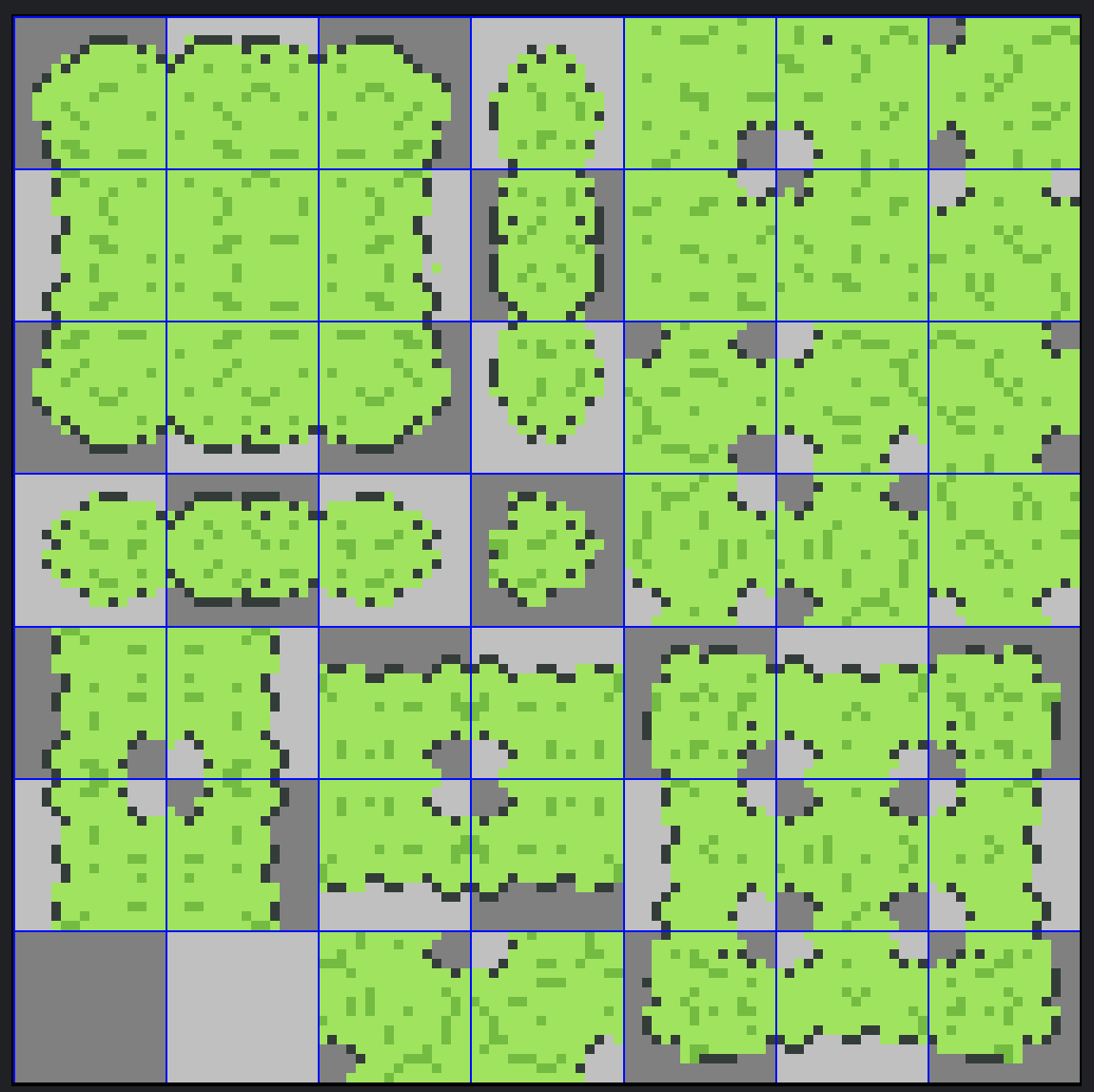
These 47 tiles represent all the different 'wall' formations that would be required. I kept my floor tiles separate in a different file so that it is easier to swap out. The floor is drawn as a separate tile underneath the wall. Each tile represented in the grid is designed to match up with a specific group of neighbor patterns. Let's take the top-left tile:
This tile is intended to be mapped to a tile where there are walled neighbors on the right, below, and bottom right of the tile in question. There maybe a few neighbor combinations ultimately that may be mapped to this tile, in my project I found 7 combinations that this tile configuration would be mapped to.
If you look through each tile you can see how it 'matches' up with another mating tile or tiles in the map. For my implementation, I spent time testing out each configuration visually to see which tile different bitmasks needed to be mapped to.
Create your tilemap data
Now we will use either a 2d matrix or a flat array in your codebase, with each index representing a tile. I use a flat array, with a tilemap width and height parameter. It is simply preference.
You can manually set these values in your array, or you can use a procedural generation algorithm to determine what your wall and floor tiles. I can recommend my Cellular Automata aarticle that I wrote earlier if you are interested in generating the tilemap procedurally. When this is completed, you'll have a data set that will look something like this.
Loop through tilemap and assign bitmasks
For each index of your array, you will need to capture all the states of the neighbor tiles for each tile, and record that value on each tile. I would refer to the previous section regarding how to calculate the bitmasks.
ts
ts
Map bitmask values to each tile sprite in spritesheet
Here is the monotonous part. For a byte, or an 8-bit word, the amount of permutations of tile patterns is 256. That's a lot of mappings. Now I did mine the hard way, manually, one by one. But there may be easier ways to do this. I use Typescript, so I will share a bit of what my mappings look like. Each number key in the object is the bitmask value, and its mapped to a coordinate array [x, y] for my spritesheet that I shared earlier in the article. Now, I could have put them in order, but that does not really serve any benefit.
ts
ts
Iterate over the tiles and assign tile sprite
The last two steps we'll do together. Now we simply need to iterate over our tilemap, assign the appropriate sprite tiles. I'm using Excalibur.js for my game engine, and the code is in Typescript, but you can use whichever tool you would prefer.
ts
ts
Demo Application

In this demo application, I'm using Excalibur.js engine to show how auto-tiling can work, and its benefits in game development. The user can click on the tilemap to draw walkable paths onto the canvas. As the walkable paths are drawn, the auto-tiling algorithm will automatically place the correct tile in its position based on the neighbor tile's walkable status.
There are some controls at the top of this app, a button to reset the tilemap settings back to not walkable, so one can start over. Also, two drop downs that let the user swap out tile-sets for different styles. This shows the benefits of having standardized Wang tiles for your tile-sets. For example, in this demo, we have three Wang tile-sets. When you swap them out, it can automatically draw them correctly into your tilemap.
Grass
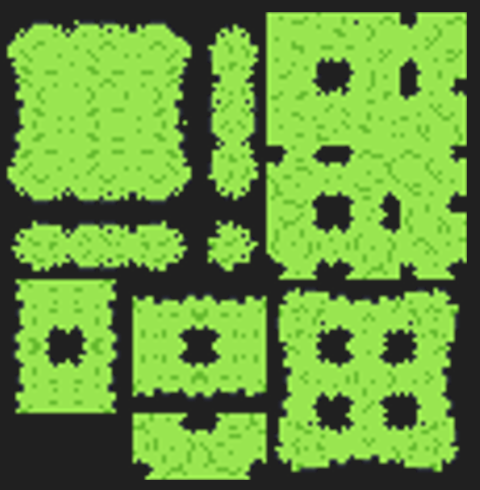
Snow
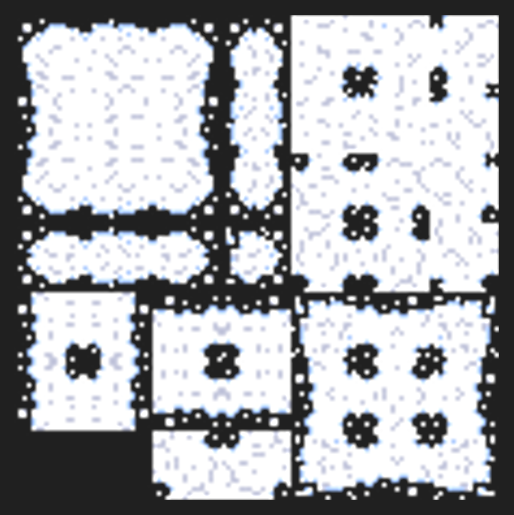
and Rock
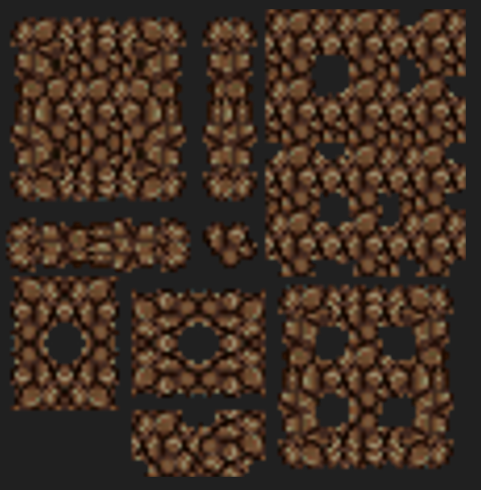
Why Excalibur
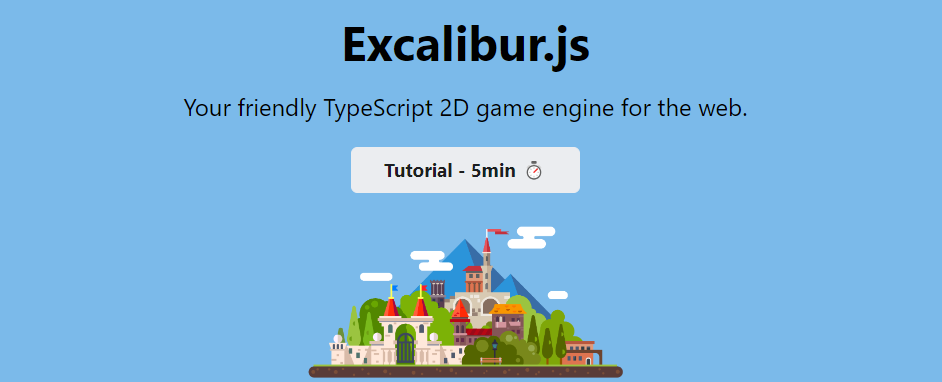
Small Plug...
ExcaliburJS is a friendly, TypeScript 2D game engine that can produce games for the web. It is free and open source (FOSS), well documented, and has a growing, healthy community of gamedevs working with it and supporting each other. There is a great discord channel for it JOIN HERE, for questions and inquiries. Check it out!!!
Conclusions
TThat was quite a bit, no? We covered the concept of Autotiling as a tool you can use in game developement. We discussed the benefits of Wang tiles for your projects and that they allow for the auto selection of the correct tile sprites to use based off of bitmask assignments. We dug into bitmask and base-2 binary encoding a little bit just to show how we were encoding the neighbor tile information into a decimal value so we could map the tile sprites appropriately. We finished this portion by doing an example tile encoding of neighbors to demonstrate the process.
We went step by step throught he process of autotiling, looking at tilesets, looking at code snippets, and finishing at the demo application on itch. I hope you enjoyed this take on autotiling, as mentioned above, this is NOT the only way to do this, there are other ways of accomplishing the same effect. You also can tweak this to your own liking, for instance, you can introduce varying tiles so you can use different floor tiles, or adding decord on to walls to add additional variety and add a feeling of greater immersion into the worlds your building. Have fun!
